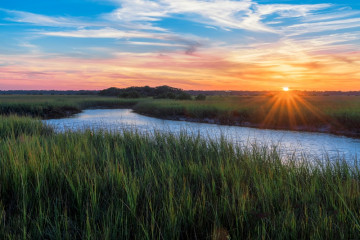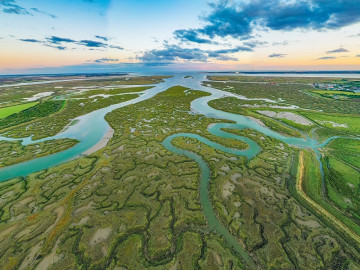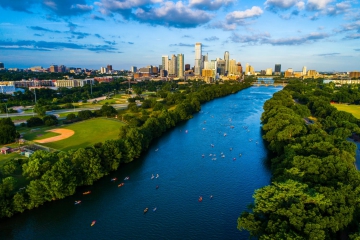What water challenges do you need to get in front of in 2021? Find out what our Antea Group global water resource experts have to say.
Our global Antea Group water team sat together virtually to reflect back on 2020 and what a rollercoaster of a year it was. They all agreed that while COVID-19 dominated the headlines, significant attention has been placed on how society and governments are awakening to the realities of climate change. With the trends of warming temperatures, fast-melting polar ice, increased incidence and severity of severe weather events, it’s clear that climate change is rearing its ugly head through the disruption of our planet’s water cycle. To further highlight this reality, we thought it would be timely to offer some global perspectives. Below, some of our water resource experts from around the world share trends they are seeing and offer solutions to get in front of these shared water challenges.
Shared Water Challenges: Declining Surface Water Resources
Julie Mouton, Food & Beverage Industry Lead, Water Stewardship Lead, Antea Group USA: Here in Texas, we have our share of water-related issues. For example, the Dallas-Fort Worth Metroplex, which are two of the nation’s topmost populated cities (#9 and 12, respectively), relies heavily on surface water resources. The region is prone to drought conditions and many of the local waterways are impacted with bacterial contamination, including the Trinity River, which is listed as an impaired waterway on the EPA’s Clean Water Act Section 303 (d) list. The region is expected to be increasingly affected by the long-term availability of water resources, as well as an increased frequency of intense rainfall events and flooding. Declining surface water resources (availability and quality) will push the region towards its groundwater resources that are already overdeveloped.
The Dallas Water Utilities is working hard to ensure the area has a clean and reliable water source, but the trends indicate that these challenges are not going away. A collective effort from a broad range of stakeholders, including the public sector, non-governmental organizations (NGOs), the business community, investors, private landowners, and entrepreneurs, is needed to get in front of these shared water challenges. While there are ongoing efforts to restore portions of the Trinity River Corridor by the groups such as the Trinity River Urban Environment (T.R.U.E.) Team and the Texas Water Resources Institute, a broader, more engaged, and well-funded collective can help expedite these efforts. For example, innovative solutions and land management strategies that protect, restore, and mimic the natural water cycle should be deployed to help intense rainfall slow down and safely recharge the surface and groundwater bodies that many people depend on.
Extreme Weather Events: Floods and Droughts
Nadia Jebbour, Senior Hydrogeologist and Water Resource Specialist, Antea Group France: Thinking back on this year, I felt that the notion of “extremes” is evolving towards a notion of “new normal.” A neighbor of mine made a comment that struck me. We live in the south of France, an area with relatively hot summers and mild winters. She mentioned that they will likely move in the next coming years as they will consider themselves “climate refugees.” I laughed. We are in the south of France, not on an island with rising sea levels or in an arid country where droughts are inducing frightening potable water shortages. But then I stopped because her remark echoed so many facts I observed throughout my work as a hydrogeologist in France. Just looking at 2020, several of my food and beverage clients in the North of France received letters from the authorities requiring them to cut back on their groundwater withdrawals due to the official droughts that were consecutively declared in 2019 and 2020. In the meantime, the frequency of devastating floods is considerably rising. According to the IPCC, heavy rainfall events will increase in frequency and intensity, inducing significant natural and human damages, as well as a strong economic impact. Floods and droughts are likely becoming regular extremes that many of us must face and have to answer with an innovative and multi-skilled approach of integrated water resource management and water stewardship.
Building on Lessons Learned to Drive Water Policy
Tom D'Haeyer, Integrated Water Resources Management, Antea Group Belgium: Until a few years ago, the West Flanders water shortage rarely was in the eye of public debate. The Flemish water policy was mostly concerned with the implementation of the European Water Directive to obtain a good ecological status of water resources and the fight against sea-level rise and inland flooding. This has now dramatically changed. What has been known by water professionals for a long time, is now slowly starting to sink in. Flanders is marked deep red on the global water scarcity map. In wintertime, groundwater tables are not sufficiently being recharged and this spring it stopped raining for the fourth year in a row. In some areas, a ban was imposed on capturing vulnerable watercourses, leaving crops withered in the field. This has stark consequences for a region that is considered the “vegetable garden of Europe.” Production lines at frozen food companies were interrupted because of a shortage in the supply chain. Economic risks are becoming more visible by the day.
Companies are facing important investment decisions for safeguarding the operations in the near future. For example, investing in large scale reservoirs, in groundwater management, reuse of effluent water of municipal wastewater facilities, etc. The Flemish Government is responding with a large-scale program called the “Blue Deal” to tackle drought. The plan is made up of more than 70 actions, including restoring wetlands, securing commitments from industry and agriculture, and establishing local drought plans. Circular water use is becoming a cornerstone in the water policy. This requires investment, policy, and regulatory instruments, as well as a stronger collaboration between stakeholders. There are many exciting challenges ahead of us as we get into this new year!
Using Science-Based Approaches to Solve Regional Water Challenges
Hilton Lucio, CEO, Antea Brazil: Time passed at a very different pace during 2020. In the first months of the pandemic, Antea Brazil observed a significant increase around the articulation of more robust water, sanitation, and hygiene (WASH) types of projects. Multiple stakeholders from the private sector joined forces to support regional initiatives with a very strong social component. As the pandemic progressed, with significantly more complex challenges popping up frequently, we observed the necessity to use much more robust and science-based approaches. This scenario is very likely to stay after the pandemic and influence the approach to water management programs. Rather than only focusing on the manufacturing plant scale, the need for more rigorous technical approaches - considering regional realities and challenges - is likely to drive some of our clients’ efforts in the coming years.
Final Thoughts
As we put 2020 behind us, let’s use the lessons this year has taught us to anticipate future challenges, being proactive versus reactionary. Let’s apply these lessons to our water stewardship approaches because water issues do not care about COVID-19 – they will be here with or without the global pandemic. What matters now is how we use these lessons and turn them into catalysts for positive change. Because after 2020, we can all use more positivity in our lives.
Want more news and insights like this?
Sign up for our monthly e-newsletter, The New Leaf. Our goal is to keep you updated, educated, and even a bit entertained as it relates to all things EHS and sustainability.
Get e-NewsletterHave any questions?
Contact us to discuss your environment, health, safety, and sustainability needs today.








